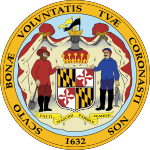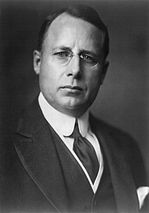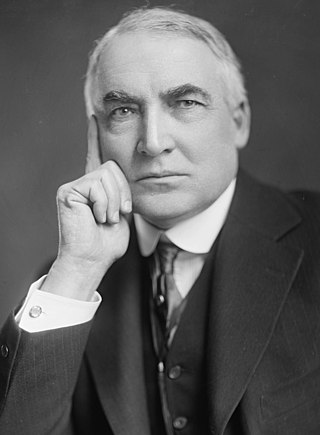
The 1920 United States presidential election was the 34th quadrennial presidential election, held on Tuesday, November 2, 1920. In the first election held after the end of the First World War and the first election after the ratification of the Nineteenth Amendment, Republican Senator Warren G. Harding of Ohio defeated Democratic Governor James M. Cox of Ohio. It was also the third presidential election in which both major party candidates were registered in the same home state; the others have been in 1860, 1904, 1940, 1944, and 2016.

The 1924 United States presidential election was the 35th quadrennial presidential election, held on Tuesday, November 4, 1924. In a three-way contest, incumbent Republican President Calvin Coolidge won election to a full term. Coolidge was the second vice president to ascend to the presidency and then win a full term.

The 1920 United States presidential election in California took place on November 2, 1920, as part of the 1920 United States presidential election in which all 48 states participated. California voters chose 13 electors to represent them in the Electoral College via a popular vote pitting Democratic nominee, Governor James M. Cox of Ohio and his running mate, Assistant Secretary of the Navy Franklin D. Roosevelt of New York, against Republican challenger U.S. Senator Warren G. Harding of Ohio and his running mate, Governor Calvin Coolidge of Massachusetts.

The 1920 United States elections was held on November 2. In the aftermath of World War I, the Republican Party re-established the dominant position it lost in the 1910 and 1912 elections. This was the first election after the ratification of the 19th Amendment, which granted women the constitutional right to vote.

The 1920 United States presidential election in Arkansas took place on November 2, 1920, as part of the 1920 United States presidential election in which all 48 states participated. State voters chose nine electors to represent them in the Electoral College via a popular vote pitting Democratic nominee James M. Cox and his running mate, Assistant Secretary of the Navy Franklin Roosevelt, against Republican challenger U.S. Senator Warren G. Harding and his running mate, Governor Calvin Coolidge.

The 1920 United States presidential election in Washington took place on November 2, 1920, as part of the 1920 United States presidential election in which all 48 states participated. State voters chose seven electors to represent them in the Electoral College via a popular vote pitting Democratic nominee James M. Cox and his running mate, Assistant Secretary of the Navy Franklin Roosevelt, against Republican challenger U.S. Senator Warren G. Harding and his running mate, Governor Calvin Coolidge.

The 1920 United States presidential election in Virginia took place on November 2, 1920. Voters chose twelve representatives, or electors to the Electoral College, who voted for president and vice president. This was also the first presidential election after the passage of the Nineteenth Amendment, which granted women the right to vote throughout the United States, including Virginia.
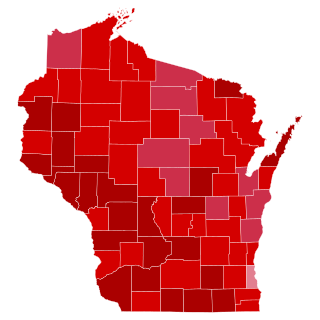
The 1920 United States presidential election in Wisconsin was held on November 2, 1920, as part of the 1920 United States presidential election. State voters chose 13 electors to the Electoral College, who voted for president and vice president.

The 1920 United States presidential election in Minnesota took place on November 2, 1920 as part of the 1920 United States presidential election in which all contemporary forty-eight states participated. Voters chose 12 electors, or representatives to the Electoral College, who voted for president and vice president. This election marks the last time a candidate for president won every county in Minnesota.

The 1920 United States presidential election in Kansas was held on November 2, 1920 as part of the 1920 United States presidential election. Kansas voters chose ten electors to the Electoral College, who voted for president and vice president.

The 1920 United States presidential election in South Dakota took place on November 2, 1920 as part of the 1920 United States presidential election in which all contemporary forty-eight states participated. Voters chose five electors, or representatives to the Electoral College, who voted for president and vice president.

The 1920 United States presidential election in Oregon took place on November 2, 1920. All contemporary 48 states were part of the 1920 United States presidential election. Voters chose five electors to the Electoral College, who selected the president and vice president. This is the earliest presidential election in Oregon to include all 36 of the state’s present counties.

The 1920 United States presidential election in Idaho took place on November 2, 1920, as part of the 1920 United States presidential election. State voters chose four representatives, or electors, to the Electoral College, who voted for president and vice president.

The 1920 United States presidential election in Illinois took place on November 2, 1920, as part of the 1920 United States presidential election. State voters chose 29 representatives, or electors, to the Electoral College, who voted for president and vice president.
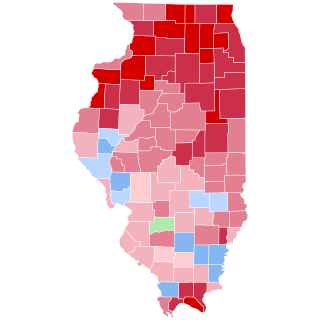
The 1924 United States presidential election in Illinois took place on November 4, 1924, as part of the 1924 United States presidential election. State voters chose 29 representatives, or electors, to the Electoral College, who voted for president and vice president.

The 1924 United States presidential election in North Carolina took place on November 4, 1924, as part of the 1924 United States presidential election, which was held throughout all contemporary forty-eight states. Voters chose twelve representatives, or electors to the Electoral College, who voted for president and vice president.

The 1920 United States presidential election in Kentucky took place on November 2, 1920, as part of the 1920 United States presidential election. Voters chose thirteen representatives, or electors to the Electoral College, who voted for president and vice president.

The 1920 United States presidential election in North Carolina took place on November 2, 1920, as part of the 1920 United States presidential election, which was held throughout all contemporary forty-eight states. Voters chose twelve representatives, or electors to the Electoral College, who voted for president and vice president.

The 1916 United States presidential election in Maryland took place on November 7, 1916, as part of the 1916 United States presidential election which was held throughout all contemporary 48 states. Voters chose eight representatives, or electors to the Electoral College, who voted for president and vice president.

The 1920 United States presidential election in Louisiana took place on November 2, 1920 as part of the 1920 United States presidential election. Voters chose ten representatives, or electors to the Electoral College, who voted for president and vice president.

